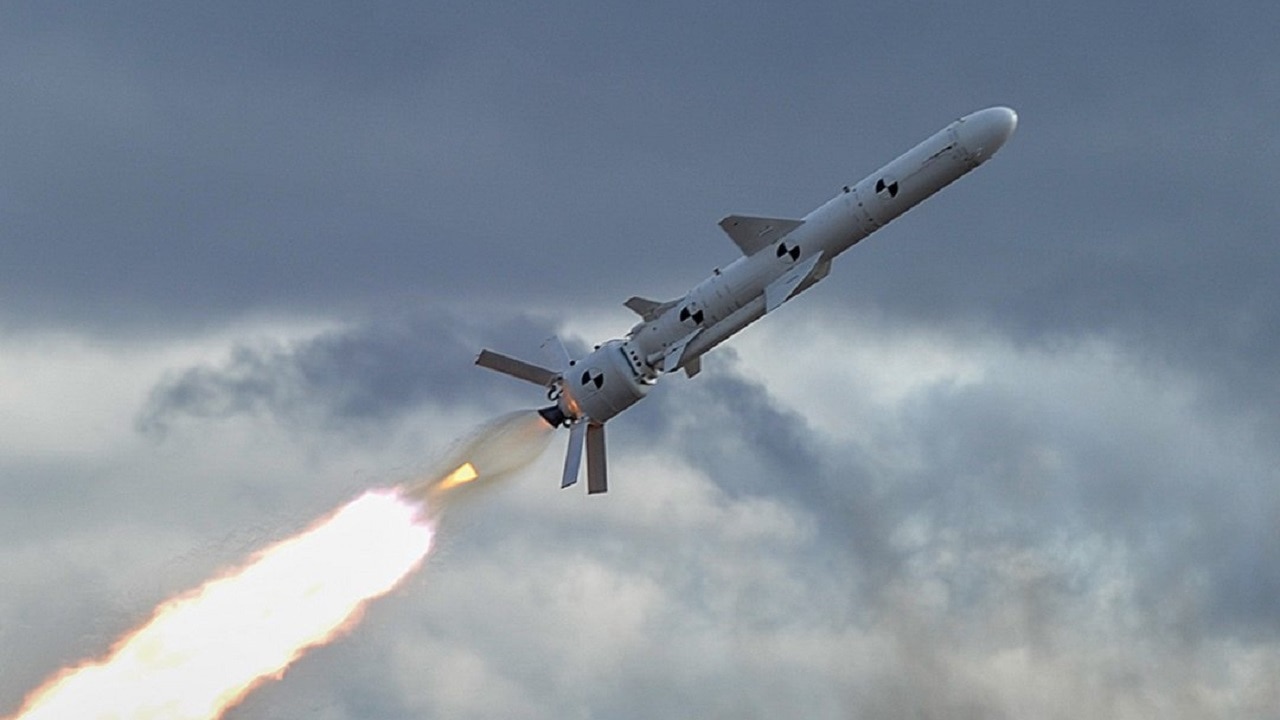4 Words: Neptune Could Strike Moscow
The R-360 Neptune missile represents a significant advancement in Ukraine’s defense capabilities, particularly in the context of the ongoing Russo-Ukrainian conflict. Developed by the Luch Design Bureau, the Neptune is a subsonic cruise missile primarily designed for anti-ship roles, with later variants adapted for land attack missions.
This assessment will delve into its specifications, capabilities, development history, and strategic impact.
Rebuilding an Old Anti-Ship Missile
The Neptune missile is based on the Soviet Kh-35 anti-ship missile but features substantial improvements in range, targeting, and electronics. It measures 5.05 meters in length, 38 centimeters in diameter, and weighs 870 kilograms.
The missile is powered by a Motor Sich MS400 turbofan engine and carries a 150-kilogram warhead. Its operational range exceeds 200 kilometers, with some variants reaching up to 1000 kilometers, and it travels at subsonic speeds.
The missile is housed in transport and launch containers and features a cross-shaped hard wing. It is guided by a combination of inertial navigation and active radar homing.
The Neptune missile was first revealed at the 2015 Arms and Security international exhibition in Kyiv. Initial flight tests were conducted in March 2016, with subsequent tests in 2017 and 2018 demonstrating its capabilities.
The missile entered service with the Ukrainian Navy in March 2021, and its first operational use was recorded in 2022. The development of the Neptune involved collaboration with several Ukrainian enterprises, including Motor Sich for the engine, Radionix for the seeker, and Arsenal SDP SE for the navigation system. This collaborative effort highlights Ukraine’s ability to develop advanced military technology despite the challenges posed by the ongoing conflict.
Ukraine Can now Stike Moscow
The Neptune missile was initially designed to defeat surface warships and transport vessels with a displacement of up to 9,000 tons, either in convoys or moving individually. Its subsonic speed and low-altitude flight profile make it difficult to detect and intercept, enhancing its effectiveness against naval targets.
One of the notable features of the Neptune is its all-weather capability, allowing it to operate effectively in various environmental conditions.
The missile’s guidance system combines inertial navigation for mid-course guidance and active radar homing for terminal guidance, ensuring high accuracy in targeting.
The introduction of the Neptune missile has significantly bolstered Ukraine’s coastal defense capabilities. Its ability to engage and destroy large naval vessels poses a substantial threat to adversaries operating in the Black Sea region.
The missile gained international recognition after being used to sink the Russian warship Moskva in the Black Sea. In addition to its anti-ship role, the Neptune has been adapted for land attack missions. The land-attack variant features a new guidance system and was first fielded in 2023.
This variant, known as the “Long Neptune,” has an extended range of up to 1,000 kilometers, allowing it to strike targets deep within enemy territory, as in Moscow itself.
When compared to other anti-ship missiles, such as the Indo-Russian BrahMos, the Neptune has certain advantages and limitations. The BrahMos is a supersonic missile with a higher speed and payload capacity, making it more lethal in certain scenarios.
However, the Neptune’s lower cost and ease of production make it a viable option for countries with limited defense budgets. The Neptune’s subsonic speed, while a limitation in terms of evading advanced missile defense systems, allows for a more straightforward and cost-effective design.
Its ability to fly close to the water surface during the terminal phase increases the likelihood of hitting the target at the water line, causing maximum damage.
Can Neptune Save a Sinking Ship?
The improvement of the new missile also comes with some concerns. With Ukraine’s industrial sector under constant bombardment, the main question is how many of these missiles can Ukraine produce? Even if the missile could bypass Russian air defenses 100% of the time, if they aren’t built in large enough numbers their battlefield impact will be limited. Russian air defense systems are also very sophisticated and can adapt based on the threat.
The more Ukraine uses its Neptune missile, the more Russia will adapt its defenses against it (it would not surprise me if some missiles have already been intercepted).
Using the Neptune missile to hit strategic targets also comes with the risk of retaliation strikes from Russia. Throughout the war, Russia has had a tendency to respond in kind whenever Ukraine hits important targets.
Neptune missile strikes come with the risk of Russia hitting targets of equal, if not greater strategic value which, given the manpower and resources differences, might not be a risk Kyiv wants to take. Most likely, the missile will be used to hit oil refineries and large groupings of enemy troops but its unlikely to be used in air defense heavy environment like Moscow or strategic airbases.
Nevertheless, Ukraine continues to enhance the capabilities of the Neptune missile. The development of the Long Neptune variant with a 1,000-kilometer range represents a significant leap in Ukraine’s missile technology.
This extended-range variant can be used for strategic strikes against high-value targets, providing Ukraine with a powerful tool for deterrence and defense.
About the Author: Isaac Seitz
Isaac Seitz, a 19FortyFive Defense Columnist, graduated from Patrick Henry College’s Strategic Intelligence and National Security program. He has also studied Russian at Middlebury Language Schools and has worked as an intelligence Analyst in the private sector.

